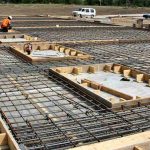1. Shallow Foundations
Types: Strips, Pads, Rafts
Shallow Foundations are common in construction and are inexpensive due to their lightweight properties. It is usually not required to employ heavy equipment for constructing shallow foundations.
Situations where they should be used in:
Shallow foundations are used when the strata at shallow depths is strong and has enough bearing capacity to support the above building loads, with respect to reasonable differential settlements. The strong strata must be consistent at the shallow depth, so that settlement can be relatively small.
● Rock or dense sand or gravel that goes towards great depths
○ However, it should be noted that shallow foundations should not be designed below GWT and when there are great uplift conditions. The more moisture content is in he soil, the less resistance the foundation gives to the above loads.
● Firm clays at shallow depths lying on top of soft clays that go towards great depths
● Uniform firm clays when there are no trees around the proximity of the foundation structure and around temporary works and where loads can be distributed on the surface area of the foundation
Situations where they can be used in with ground improvement techniques:
● Loose sands and soft clays at great depths
○ Ground improvement should be used because towards the greater depths, groundwater level changes. Also, vibration of equipment can cause overall and differential settlement.
● Peat
○ Consider the acidity of soil when implementing ground improvement techniques
● Fill
○ More appropriate if the fill is well compacted which will create a higher bearing capacity
● Stiff or high density sand or clay on top of soft clay lying over compact clays at great depths
● Sloping site where sloping effects should be considered and support, such as ground improvement and temporary works, should be used to construct the foundation
● Site with high GWT where dewatering techniques should be used
2. Deep Foundations
Types: Piles (Click to learn the different types of piles)
Deep foundations are heavy foundation structures used to transmit heavy loads created from loading and self-weight of the superstructure into the soils of the deep stratum. They can prevent large differential settlements that will affect the strength and robustness of the building. Information that need to be included during scheme design consist of:
● Number of piles
● Diameter of piles
● Thickness of pile caps
Situations where they should be used in:
Deep foundations are used when the strong strata is located at a depth and piles, caissons, or piers are driven or bored to the strong strata so that structural columns or walls can transmit loads directly to the rock strata. Deep foundations are also used when the soils between the surface and the rock strata has high settlement rate, such as peat and silt. Loads are transmitted and resisted by end-bearing and skin friction.
● Weak soil stratum or loose sand underneath strong or weak stratum
○ Driving piles can also help to increase the density of sand and stiffness of clay
● Uniform stiff and firm clays, with trees at the proximity of the foundation
○ Even though trees can affect the shrinkage and expansion of soil, trees will not affect the foundation negatively due to piling.
● Peat
○ Consider drag on piles and acidicity of soil when implementing ground improvement techniques
● Suitable for high water tables and uplift conditions
○ Deep foundations do not need as much dewatering as shallow foundations
○ Bored piles should be cased to prevent water damage to piles
○ Temporary works should be carefully designed for the stability of the foundation
● Stiff or high density sand or clay on top of soft clay lying over compact clays at great depth
● Soft clay on top to stiff clay at great depths
○ Use deep bored piles with casing
● Proposed foundation is close to adjacent building
○ Use sleeves with the piles to prevent surcharge or undue stress onto the adjacent existing foundation and building superstructure
● Sloping site where temporary works design and sloping effects should be considered
If applied building loads are more than the allowable bearing capacity, ground improvement techniques should be used to strengthen the foundation or the soil strata. One method is the use of vibro replacement stone columns. This technique increases the bearing capacity and decreases soil settlement. Crushed coarse aggregates are to be placed by vibrators into areas of soil where bearing capacity needs to be increased. Not only do the aggregate replaces the soil that carries low bearing capacity, the aggregates induce additional pressure onto the soil and the vibrator increases the density of the soil by compaction of air pores in the soil, which increases the bearing capacity.



Comments are closed